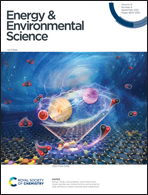All solid thick oxide cathodes based on low temperature sintering for high energy solid batteries†
Abstract
Solid-state batteries (SSBs) could significantly improve the safety and energy density over conventional liquid cells. One key enabling technology is the use of solid electrolytes. NASICON-type Li1.3Al0.3Ti1.7(PO4)3 (LATP) is a very attractive solid-state electrolyte for the cathode side due to its high oxidation potential and high ionic conductivity. The usage, however, is limited by its large interfacial resistance against most of the cathode materials as well as the thermodynamic instability during high temperature sintering needed to achieve high mass density. Here we construct thin, percolative, and mixed conductive interphases through in situ low-melting-point liquid sintering. These mixed conductive interphases drastically improve the kinetics, leading to high-loading solid LATP/LiCoO2 cathodes achieving capacity loading of up to ∼6 mA h cm−2. The technique is also applicable to Ni-rich cathode materials, achieving up to ∼10 mAh cm−2, which can lead to more than 400 W h kg−1 cells in SSBs. Our composite cathodes show a ten-times and three-times area capacity improvement over the state-of-the-art cathodes using oxide and sulfide SSEs, respectively.



 Please wait while we load your content...
Please wait while we load your content...